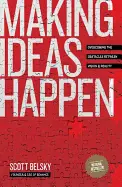
Making Ideas Happen - by Scott Belsky
ISBN: 1591844118Date read: 2013-12-20
How strongly I recommend it: 6/10
(See my list of 430+ books, for more.)
Go to the Amazon page for details and reviews.
The full title - “Making Ideas Happen: Overcoming the Obstacles Between Vision and Reality” - describes its contents perfectly. Great book on that subject.
my notes
Many claim they create solely for themselves. But this argument is selfish: an idea executed for an audience of one is an awful waste of potential inspiration and value for the greater good.
Making ideas happen = (the idea) + organization and execution + forces of community + leadership capability
Creativity x Organization = impact
Someone who has loads of ideas but is so disorganized that no one particular idea is ever fully realized. 100 X 0 = 0.
Someone with half the creativity and just a little more organizational ability would make a great deal more impact: 50 X 2 = 100
The equation helps us understand why some “less-creative” artists might produce more work than their talented and inventive peers. A shocking and perhaps unfortunate realization emerges: someone with average creativity but stellar organizational skills will make a greater impact than the disorganized creative geniuses
Thomas Kinkade and James Patterson employ many people to assist in the production and distribution of their work.
Before authoring his first novel, Patterson was the CEO of J. Walter Thompson, one of the world’s top ad agencies. Climbing the ladder to CEO, he developed the strengths as a leader and organizer that have distinguished his performance as a writer. Regardless of what the critics say, Patterson makes ideas happen at an almost alarming rate.
Brainstorming sessions often yield disappointing results. Ideas with great potential fade from the participants’ minds with each additional idea thrown into the mix. Strong possibilities are trumped by alternative - not necessarily better - possibilities.
A surplus of ideas is as dangerous as a drought. The tendency to jump from idea to idea to idea spreads your energy horizontally rather than vertically.
Approach every occasion of creativity with a dose of skepticism and a bias toward action.
For each idea, you must capture and highlight your “Action Steps.”
Each person needs to “own” their Action Steps.
Taking and organizing extensive notes aren’t worth the effort.
Everything is a project.
Breaking each one down into its primary components: Action Steps, References, and Backburner Items.